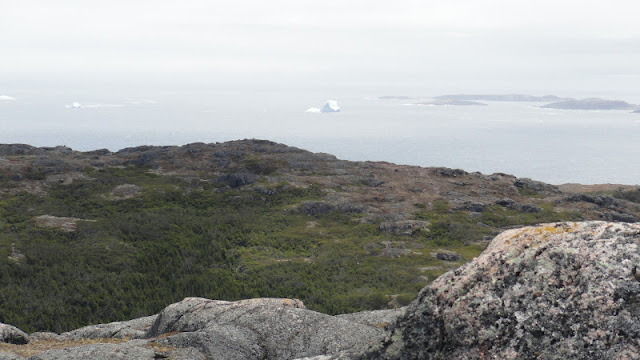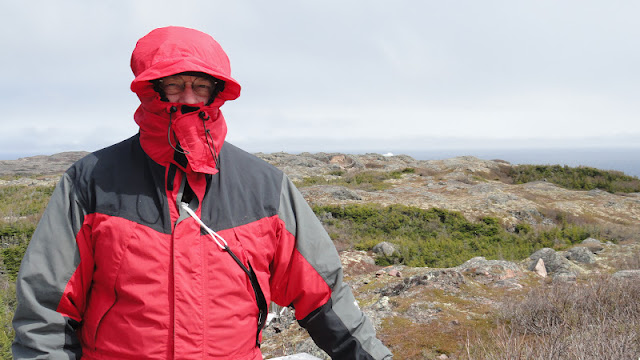As we were sitting on a rock enjoying the view a weathered
looking local fellow stopped to sit and visit for a while. I just love to listen to the locals talk -
love the accent and love the turns of a phrase. I wish I’d have been able to record
him.
He said he’d lived there all his life and hunted. I asked him what he hunted, he said mostly
partridge, rabbit, porcupine and so on.
Of course, he said, you had to be very careful when you skin a
porcupine, cuz of the spines. I asked
how he prepares porcupine and he said mostly baked but sometimes fried up. He said it’s better eatin’ than rabbit.
He told us that one night this past winter his dog started
barking, but didn’t want to go outside when he opened the door to let him out. When the fellow looked out the screen door he
came face to face with a polar bear who was looking back at him! He said he was stuttering trying to tell his
wife what was going on, went into the living room and there was the bear again,
looking at him through the living room window.
He ended up shooting his gun off to scare the bear, and the bear did
finally take off.
On the way back down the path we passed a young couple
heading up the path and nodded our hellos.
John noticed he didn’t see another car parked by ours and wondered how
they got to the path. I suggested their
car might not have been able to make the steep rutty drive to the trail head
from the ‘main’ road, and sure enough, we saw a small Toyota Yaris hybrid parked
at the bottom of the steep trail head access road. More about the Yaris later.
Our next stop was the small village of Lodge Bay, listed in
the Labrador Coastal Drive brochure as one of the most picturesque villages on
the drive. Well….. not exactly.
However, John drove up one lonely dirt road at the edge of town that climbed to a
hilltop and ended at an old cemetery. We
decided to eat lunch, Chris grumbling that it wasn’t a very pretty setting and
there was no water view, wah wah wah.
When we rolled down our windows though, we clearly heard the sound of
rushing water. ‘Aha!’, we both inferred
when we looked at each other – John with a bit of an ‘I told you so’ look in
his eye, and Chris with a bit of an ‘ok, you were right’ look in her eye.
We went to check it out and saw a couple of
footbridges. As we were heading toward
them, a fellow with a pole and hand held fish net came past us and nodded a
hello. We followed, and saw a beautiful roaring
mountain stream thundering down to the Bay.
(John describes it as high discharge, supercritical flow,
with a Reynolds number greater than 500 in some places, the flow perturbed by
cubic yard sized well rounded boulders.)
(Chris describes it as a beautiful roaring stream.)
Chris was sorry the pictures wouldn't capture the sound, so
decided to take a video of it. As good
fortune would have it, just at the time she was filming, the fisherman got a
catch, and we were able to film him landing a beauty of a trout! So it was a nice little unexpected
celebration party right there on the footbridge in Lodge Bay, Labrador.
You can watch the video on my YouTube channel:
I guess is the moral of the story is, always go for the
road less traveled.
 |
| Notice he's standing OUTSIDE the railing above this really thundering stream. |
 |
| Getting down that bank with the water flowing as fast as it was is not for the faint of heart. |
 |
The prize!
(uh, that would be the trout, not me) |
In this stretch of Labrador known as the Labrador Straits, the
villages are much closer together. Hence
our ability to stop several times throughout the day. I guess we’re officially out of the
wilderness now. Sigh….
Red Bay was our next stop.
We got there just in time to
get a quick but reasonably adequate look at the whaling museum there. John was particularly fascinated by it.
Red Bay had been a whaling port as early as
the 16th century when Basque sailors used it seasonally to hunt
whale for oil and baleen. It earned its
name by the amount of whaling blood in the bay – so much that it turned the
water red. Pretty grisly and shameful by
today’s social mores, but at that time, whale oil was a main source of oil used
for lamps. Baleen was used for a variety
of things as well.
 |
| Can you imagine this beautiful bay running red with the blood of whales? It's a tragedy we still haven't recovered from. The primary targets were the right whales, members of the bowhead family, called right whales because it was the 'right whale' to catch - easy pickins - and they still are endangered. |
 |
| Closer up shot - notice the ship wreck just before the rocky promontory and the ice berg at sea. |
More shameful to my
mind is the 15 years that the museum guide told us about when the baleen became
more valuable than the oil - primarily due to women’s fashions – corsets and
such that used baleen to make stays.
During those years, sailors would kill the whales, cut out the throats
and leave the rest of the animal to rot.
It’s just like today when poachers kill elephants only for their tusks,
or rhinos only for their horns or sharks only for their fins, or bear only for
their glands, etc etc.
 |
| Bowhead whale flipper skeleton and model of basque whaler from the 1500s. The museum has some actual clothing worn by these men, and it was interesting to see how small they were. Much smaller than average men today. |
 |
| Reconstructed 400 year old 'chaloupe' whaling boat alongside a 17.5 foot bowhead mandible from an individual they believe was about 50' long. |
 |
| Interior of the chaloupe |
 |
| This beautiful and wonderfully detailed model shows the cross section (below) of a typical basque whaling ship of the time |
We stayed till the museum closed at 6:00 and then walked
across the parking lot to have dinner at the Whaler’s Restaurant where we split
an order of their specialty, fish and chips.
Good stuff.
On the way to Blanc Sablon, we crossed the Pinware river. Pinware Provincial Park was an area I had hoped to visit, but that will have to be another trip. We just didn't have enough time to do everything we wanted to.
 |
| Looking upstream of the Pinware River from the bridge. Notice that the banks on both sides are smoothed solid bedrock. Way cool! |
And soon it was goodbye to Labrador. We crossed the border back into Quebec at
Blanc Sablon and waved goodbye to the Big Land in our rear view mirror. Hopefully we’ll get just a touch more of it
on our way back from Newfoundland, and explore a bit of L’Anse Amour and L’Anse
au Clare.
Our room this night was at the Quatre Saisons, or Four
Seasons B&B in Blanc Sablon, Quebec.
We’ll stay there again when we come back from Newfoundland. The room was nice and the breakfast good and
filling. Our host is part Newfie, part
aboriginal and part French, I think it was.
Point of interest:
Everywhere we stayed, even in the most
remote parts of Labrador, we had access to wireless high speed internet, but no
cell phone service along the entire route so far. Hmmm.
















































No comments:
Post a Comment